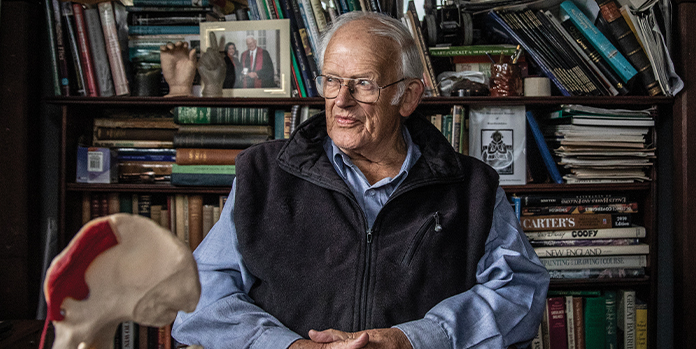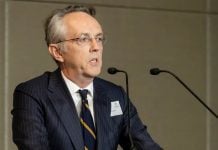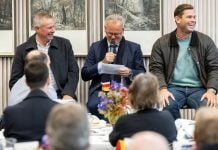Professor Geoffrey Ian Taylor AO (OM 1957) is a highly respected and influential surgeon in the world of plastic and reconstructive surgery. Over the course of his 50+ year career, his research and self-invented surgical procedures have revolutionised many specialities.
“I come from a whole line of tradies on my mother’s side. I call myself a tradie, but I work in flesh, not timber. It was natural for me to do something with my hands, which I’ve loved doing all my life.”
Ian decided to study medicine only because his best friend at Melbourne Grammar School, Wallace Watson (OM 1957) had enrolled in a medical degree. He wasn’t precisely sure where his training might lead until relatively late in his own degree.
After making a small finger repair in a Hospital Emergency Department, Ian remembers thinking “plastic surgery looks interesting; I’ll go and watch a surgeon doing some work”.
And it so happened that Sir Benjamin Rank, Australia’s pioneering post-war reconstructive surgeon, was operating in a nearby theatre. Ian explains “I went up snuck in and quietly watched over his shoulder as he put a little graft onto a patient’s face where he’d taken a skin cancer off. He was putting in tiny little stitches, using tiny little knots and carefully dressing it. He was absolutely meticulous and I thought to myself ‘Hey this is good’”.
In addition to the finesse he witnessed that day and in the days afterwards, Ian says that he also fell in love with plastic surgery because of the obvious effect that it had on people’s lives.
“Basically, as a plastic surgeon, you’re improving the quality of life for people by trying to repair something that’s missing or deformed, or something that is damaged and has to be repaired. And that for me is the most rewarding thing about plastic surgery.”
A breakthrough in technique
“In plastic and reconstructive surgery, every patient is different – it doesn’t matter if it’s a mole you’re taking off or a damaged leg you’re repairing. You have to customise your operation to match the patient.”
So, early in his career when Ian found that current procedures weren’t sufficient to meet his needs, he invented his own – and these ultimately transformed surgical procedures across the world.
In 1973, Ian performed a world first surgical procedure at Preston and Northcote Community Hospital – the Free Flap. He used it to successfully repair a badly damaged ankle. It is now a common procedure used across numerous surgical disciplines.
Rather than using the existing technique of transferring tissue from one part of the body to the damaged recipient site through a series of surgical steps designed to grow the tissues blood supply, often involving multiple surgeries over 12 to 24 months, Ian had developed a successful and different approach.
He surmised that certain areas of skin, soft tissue and bone had a common blood supply. That meant he could lift a particular area of skin, together with the underlying tissue and, importantly, its supplying artery and vein. This transplant could then be used, for example, to repair a jaw defect following a gunshot wound or removal of a cancer.
By reconnecting the blood supply to the transplant using microsurgery, placing it over damaged tissue and then connecting the flap blood supply to that of the affected area, “in two or three hours we had reconstructed a problem that could have taken two or three years previously”.
That wouldn’t be the only time Ian would perform world-first surgery. He and his team extended the technique to include transplanting nerves, bone, tendons, and pieces of muscle each with their own blood supply.
Ian named the ‘free’ tissue section of skin, muscle and bone an ‘angiosome’. Over the past 40 years he and his research team have mapped all the human angiosomes. They not only identified the blood supply for each of these areas, but also mapped the human nerve and lymphatic supply to each angiosome.
The academic paper Ian wrote documenting his initial work won the esteemed American Association of Plastic Surgeons’ James Barrett Brown Award for the best plastic surgery-related paper in 1976. While it is unusual for anyone to win it twice, since then, the prodigious publisher of pioneering research, Ian, has won it three additional times each in recognition of new ground-breaking work.
Making giant leaps in surgery and beyond
But Ian’s work is not limited to repairing and reconstructing skin and bone, and mapping the human body. It has had profound implications in the fields of embryology, oncology and even zoology.
“We have found that the basic pattern – the biological blueprint – in all mammals is the same except for the skin. All your muscles and bones and so forth develop in a very similar way – but in different proportions.
“But we have found that the skin of different animals varies. In some, like a pig, it’s fixed. And in others, like a rabbit, it’s very mobile. The rabbit, at one extreme, has got two arteries supplying blood to its whole tummy. The pig, at the other extreme, has 20 along the way that do the same thing.”
Much of the work done in this area concentrated on animals typically used in research. But Ian says he and his colleagues “got to know a few people at the zoo” and began to map the skin of larger animals.
“When we recently examined the giraffe, we found an extraordinary pattern of blood supply to its skin. But it didn’t match necessarily with skin mobility; it matched its patches.
“Every patch on the giraffe has a single artery supplying it – like a mushroom – that controls its body temperature. It is absolutely unique. If we look at the zebra, which has stripes, it doesn’t have vessels running along the black bit, and different ones along the white; it has the same pattern of blood supply to the skin as a horse. But a giraffe is totally different. Its evolutionary pathway has gone one way and everything else has gone the other.”
Such a major discovery has brought attention from around the world including from a man Ian idolises.
“I’ve had two hand-written letters from David Attenborough about [the research]. It’s been fantastic. It’s probably one of the highlights of my life because he’s my hero.”
An insatiable hunger for knowledge
Ian is 85 and is still undertaking important research, “keeping his hand in” surgery by attending ward rounds at the Royal Melbourne Hospital and is still dissecting at the University of Melbourne. He is an Emeritus Professor at both institutions.
Ian puts his indefatigable disposition down to unflagging curiosity, a genuine love of his work, and a wonderful wife, Claudette, and his family.
“I love a challenge to find an answer to something that’s not known. That inspires me with my research. But everything I’ve ever done, has been looking for another answer to something. And it’s taken me in all sorts of directions.
“I haven’t worked a day in my life; I’ve loved every second of it.”



